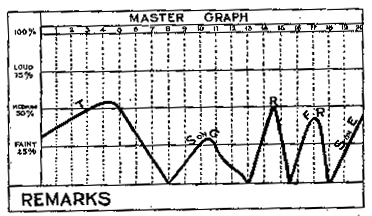
The following has been extracted from that otherwise unremarkable book Hush, or the Hydrophone Service, by H. W. Wilson (Mills & Boon, 1920), pages 27 - 32. Hydrophones were a major technological advance in the war against the German submarine - this extract provides a hint as to what was actually heard through the hydrophones.
The method of recording one's observations was known as 'graphing', and the impression as a 'graph.'
The illustration will perhaps help to make the principle clear.

You retreat en masse [the author is describing a training course] into the bowels of the ship, where you must rely solely upon the efficiency of the hydrophone and your telephone receivers. If you are wise you have got down first, and annexed the most comfortable position, and perhaps the best telephone receivers.
You can, of course, see nothing except the familiar presences of your comrades. it is up to you to listen, and record your aural observations on your 'graph', what time a somnolent P. O. keeps the clock for thirty minutes, the usual duration of the 'graph', recording the passage of time thus: 1, 2, 3, 4, 5, etc., only missing the minutes when he is actually asleep.
Meanwhile an officer, 'the master-grapher', sits in the wheel-house, with telephones on his ears and an unobstructed view. He is the examiner and marks the 'graphs'...
[...] Now for a brief description of that 'master-graph', a fine piece of imagination! The T curve would represent a turbine engine that is already running at medium intensity at the beginning of the 'graph.' It dies away at the end of seven and a half minutes. Just after the commencement of the eighth minute a submarine on gas, ie on the surface, is heard, to be succeeded, as is shown, by a reciprocating engine, then a fast 'recip', such as a motor launch, and lastly a submarine running on electric motors.
You have here representatives of the two characteristic types of engine sounds.
The reciprocating family tree claims among its branches the plain 'recip,' the fast 'recip,' and also the motor launch, and the 'sub' on gas, though the latter are of the combustion type; while the turbine and the submarine on electric motors, belong to the rival firm of rotary engines.
[...] A word or two is called for on the nature of these sounds.
We have talked about turbines, 'recips,' submarines on gas, or electric motors. Let us just consider what these engines actually sound like as heard on the hydrophone.
The characteristic of the turbine is continuity, as opposed to a distinct beat. The pitch of sound will vary from a shrill whistle, when the vessel is distant, to a roar resembling the passage of a train through a tunnel, if the ship approaches the hydrophone closely.
The distant note resembles the sustained vibration of the E string of a violin, and it is astonishing from how great a distance it may be heard. A sharp turn of helm by a destroyer (which class of vessel is of course turbine-engined) is reproduced by a clear bell-like note, lasting for a few seconds. This, no doubt, is the auxiliary turbine engine in operation, while the actual turn is being made, working the helm. [??? turbines were not used for steering engines - the author is mistaken here]
The ordinary slow or medium beat reciprocating engine once heard, can hardly be mistaken for anything else. There is a cycle of one major beat followed by three minor.
The varieties of fast 'recip' are more difficult to diagnose correctly, though those of the combustion type suggest an even-spaced and continuous tapping.
An endless source of confusion is created by auxiliary engines, and hammering, whether manual or mechanical. Particularly is this the case if the vessel under observation is of considerable size.
Lastly we come to the briefest consideration of the submarine running on electric motors, which is, after all, far and away the most important of all engine sounds.
I have heard this sound, as recorded through the receivers, likened to the rotary motion of a spoon in a tea-cup. Another description is a rhythmical sawing of wood.
Personally I consider that the latter description is particularly happy. This, in my opinion, accurately describes the 'timbre' of the sound. It merely remains to observe that no engine more clearly indicates that the something to which you are listening is actually going round than does the electric motor. In other words it shouts the word 'rotary' at you through the telephones.
Return to WWI The Maritime War
Return to WWI Archive main page.